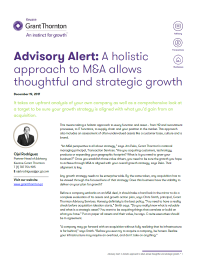-
Financial statements audits
Financial statement audits
-
Compliance audits
Compliance audits
-
Compilations and reviews
Compilations and audit
-
Agreed-upon procedures
Agreed-upon procedures
-
Corporate and business tax
Our trusted teams can prepare corporate tax files and ruling requests, support you with deferrals, accounting procedures and legitimate tax benefits.
-
International tax
Our teams have in-depth knowledge of the relationship between domestic and international tax laws.
-
Tax compliance
Business Tax
-
Individual taxes
Individual taxes
-
Estate and succession planning
Estate and succession planning
-
Global mobility services
Through our global organisation of member firms, we support both companies and individuals, providing insightful solutions to minimise the tax burden for both parties.
-
Sales and use tax and indirect taxes
SUT/ VAT & indirect taxes
-
Tax incentives program
Tax incentives program
-
Transfer Pricing Study
The laws surrounding transfer pricing are becoming ever more complex, as tax affairs of multinational companies are facing scrutiny from media, regulators and the public
-
Business consulting
Our business consulting services can help you improve your operational performance and productivity, adding value throughout your growth life cycle.
-
Forensic and investigative services
At Grant Thornton, we have a wealth of knowledge in forensic services and can support you with issues such as dispute resolution, fraud and insurance claims.
-
Fraud and investigations
The commercial landscape is changing fast. An ever more regulated environment means organizations today must adopt stringent governance and compliance processes. As business has become global, organizations need to adapt to deal with multi-jurisdictional investigations, litigation, and dispute resolution, address the threat of cyber-attack and at the same time protect the organization’s value.
-
Dispute resolutions
Our independent experts are experienced in advising on civil and criminal matters involving contract breaches, partnership disputes, auditor negligence, shareholder disputes and company valuations, disputes for corporates, the public sector and individuals. We act in all forms of dispute resolution, including litigation, arbitration, and mediation.
-
Business risk services
We can help you identify, understand and manage potential risks to safeguard your business and comply with regulatory requirements.
-
Internal audit
We work with our clients to assess their corporate level risk, identify areas of greatest risk and develop appropriate work plans and audit programs to mitigate these risks.
-
Service organization reports
As a service organization, you know how important it is to produce a report for your customers and their auditors that instills confidence and enhances their trust in your services. Grant Thornton Advisory professionals can help you determine which report(s) will satisfy your customers’ needs and provide relevant information to your customers and customers’ auditors that will be a business benefit to you.
-
Transaction advisory services
Transactions are significant events in the life of a business – a successful deal that can have a lasting impact on the future shape of the organizations involved. Because the stakes are high for both buyers and sellers, experience, determination and pragmatism are required to bring deals safely through to conclusion.
-
Mergers and acquisitions
Globalization and company growth ambitions are driving an increase in M&A activity worldwide as businesses look to establish a footprint in countries beyond their own. Even within their own regions, many businesses feel the pressure to acquire in order to establish a strategic presence in new markets, such as those being created by rapid technological innovation.
-
Valuations
We can support you throughout the transaction process – helping achieve the best possible outcome at the point of the transaction and in the longer term.
-
Recovery and reorganization
We provide a wide range of services to recovery and reorganisation professionals, companies and their stakeholders.
It takes an upfront analysis of your own company as well as a comprehensive look at a target to be sure your growth strategy is aligned with what you’d gain from an acquisition.
This means taking a holistic approach to every function and asset – from HR and recruitment processes, to IT functions, to supply chain and your position in the market. This approach also includes an assessment of often-undervalued assets like a customer base, culture and a brand.
“An M&A perspective is all about strategy,” says Jim Peko, Grant Thornton’s national managing principal, Transaction Services. “Are you acquiring customers, technology, products or expanding your geographic footprint? What is it you need to grow your business?” Once you establish those value drivers, you need to be sure the growth you hope to achieve through M&A is aligned with your overall growth strategy, says Peko. That alignment is key.
Any growth strategy needs to be enterprise-wide. By the same token, any acquisition has to be viewed through the focused lens of that strategy: Does this business have the viability to deliver on your plan for growth?
Before a company embarks on an M&A deal, it should take a hard look in the mirror to do a complete evaluation of its assets and growth action plan, says Chris Smith, principal, Grant Thornton Advisory Services. Honesty definitely is the best policy. “You need to have a reality check before acquisition ideation starts,” Smith says. “Do you really know what is valuable and what is a strategic asset? You want to be acquiring things that correlate or build on what you have.” Put on paper all assets and their value, he says. C-suite executives should be in agreement.
“A company may go forward with an acquisition without fully realizing that its infrastructure is far behind,” says Smith. “Before you even try to acquire a company, be honest. Realize your infrastructure may require an overhaul, and don’t take on anything.”
Avoid these 6 reasons deals fail
The broad purpose of any M&A deal is to grow and increase profits and enterprise value. Yet the majority of deals fail, and many have reasons in common.
Limited due diligence. Due diligence cannot be limited to financials and tax (although the tax function should be involved early on in the M&A process). True, companies need to take a hard look at the financials and tax, but they also need to move beyond traditional diligence and focus on areas such as the quality of all aspects of operations (including the workforce), transitional or cultural diligence and a hard assessment of transaction, business and market risks.
Cultural integration issues. These issues need to be evaluated and differences reconciled, whether through an integration of cultures that works for all sides or by allowing respective units to run themselves. Any approach requires clear strategies.
Overpaying. Paying too much can be avoided by having a detailed planning process and focusing on the drivers of value throughout the process as opposed to waiting until the deal closes. Speed to attaining the synergies enhances value and increases the likelihood of success.
Overestimating cost savings and synergies. When this happens, a deal may well fail.
Lack of clarity in a deal’s execution. A slow start to operational integration after a merger frustrates all parties, including employees, customers and shareholders.
Taking a knee-jerk reaction to a deal. Resist pressure to go forward with a deal until you’ve done a thorough, enterprise-wide evaluation. At the same time, don’t damage a done deal by focusing on short-term gain while putting long-term goals at risk.
Why a holistic approach matters?
Peko concurs that a clear, complete assessment is necessary. “Companies need to take a holistic approach that focuses on driving value throughout the process with a defined strategy today more than ever because of where valuations are in the market,” he says. “We have historically high valuations, lots of liquidity, a very competitive market situation. You can’t do just financial diligence and confirm what EBITDA (earnings before interest, tax, depreciation and amortization) is. How do you create value and strategic advantage for yourself in a competitive process?”
You do that through an enterprise-wide method that evaluates all aspects of a deal. “Is the IT system up to date? Can you consolidate the supply chain to drive value? Is the business model significantly affected by the leasing standards changes? Are there going to be pitfalls from a cultural perspective?” Peko asks. “Know all that ahead of time so you can make adjustments.”
A lot of companies don’t look at everything they should as assets, says Smith – for example, their customer list. “They may have access to thousands of people that all act this way and look this way and buy this way – yet they don’t view that as an asset with value.”
The same can be said for culture.
Cultural misalignment is a big cause of deal failure. “Cultural integration can be a slippery killer of deals,” says Smith. “CFOs may roll their eyes [when it comes to viewing culture as an asset]. But if no one did an assessment of cultures, people may be disconnected and they leave.”
Cultural differences that go unaddressed frequently lead to mass defections. The same can be said for uneven compensation and benefits structures.
Says Peko: “A CFO is thinking -- about whatever is put on the table as a tactic to grow -- what is the probability it will be successful? How accurate are the projections? If we go forward with a deal, are we going to achieve the synergies in the underlying investment thesis and capture projected value?” No one wants to be the one to tell the CFO who supported a big initiative to acquire a growth target that the target needs an unforeseen new technology system for $4 million.
“The board and the C-suite need to have an M&A strategy in place,” says Peko, “and the business must have the proper infrastructure in place. Deals fail when they don’t.
“We often don’t see acquirers take as deep a dive as they should when targeting healthy companies” Peko says. “When targets are in distress, the buyers tend to be more cautious and take a more comprehensive look at the value drivers. If we can get clients to take a deeper dive analytic on a healthy company, and what has value, particularly on things like a customer base – we can better leverage that to create enhanced cash flows, drive revenue growth and create enterprise value.”
Source: Grant Thornton | A holistic approach to M&A allows thoughtful and strategic growth


